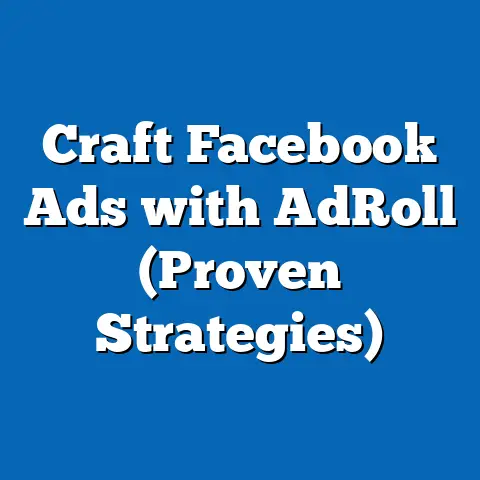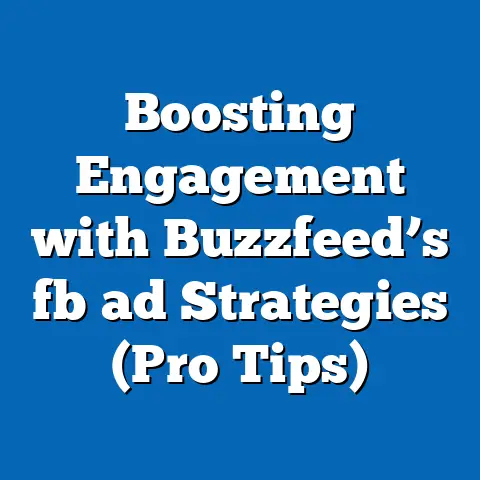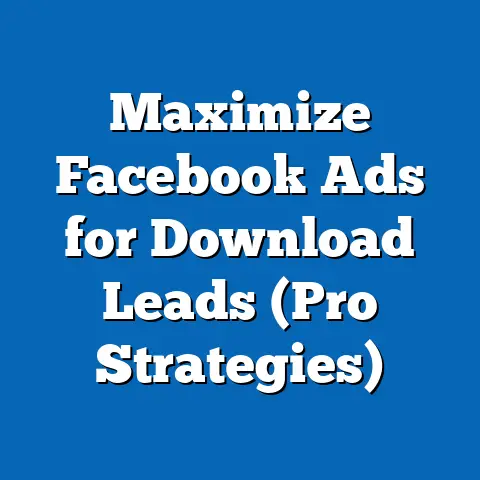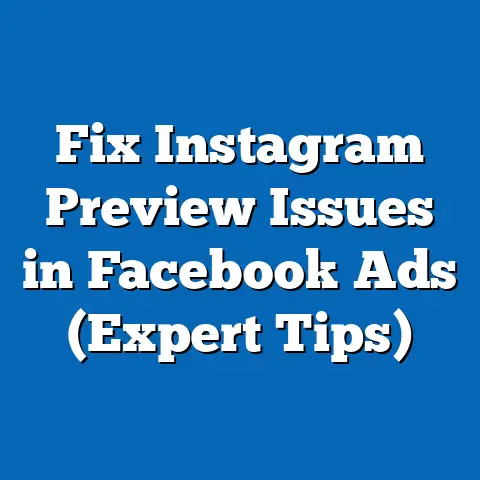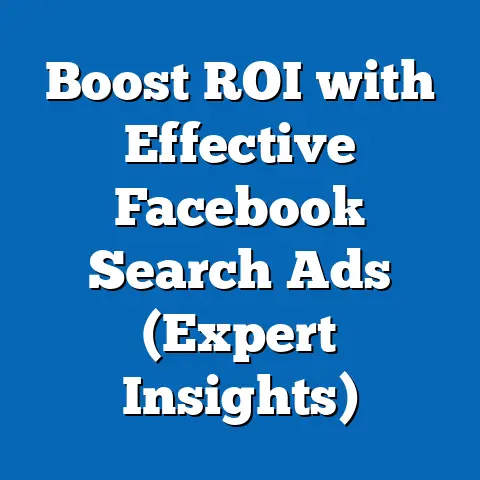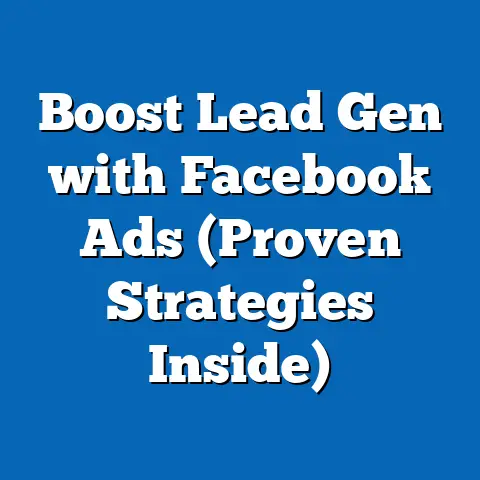Scale Facebook Ads Successfully (Future-Proof Strategies)
Scaling Facebook ads in today’s hyper-competitive digital advertising space presents a formidable challenge for marketers and businesses alike. With over 2.9 billion monthly active users as of 2023 (Statista, 2023), Facebook remains the largest social media platform, yet its advertising ecosystem has become increasingly crowded, with ad costs rising and audience attention fragmenting. The average cost-per-click (CPC) on Facebook increased by 17% year-over-year to $0.97 in 2022 (WordStream, 2023), while click-through rates (CTR) have stagnated at around 0.9% across industries, signaling diminishing returns for many advertisers.
The Growing Complexity of Scaling: Key Statistical Trends
The landscape of Facebook advertising has transformed dramatically over the past decade, with scaling becoming a high-stakes endeavor. In 2022, global ad spend on Facebook reached $113.6 billion, representing a 6.1% increase from 2021 (eMarketer, 2023), yet many advertisers report declining return on ad spend (ROAS) as competition intensifies. Small and medium-sized businesses (SMBs), which make up 90% of the 10 million active advertisers on the platform (Meta, 2023), face particular challenges in scaling due to limited budgets and expertise.
Moreover, ad fatigue is a growing concern, with studies showing that 74% of users feel frustrated when content feels irrelevant (HubSpot, 2022). This underscores the need for hyper-targeted campaigns, yet privacy changes—such as Apple’s App Tracking Transparency (ATT) framework introduced in 2021—have reduced tracking capabilities, costing Meta an estimated $10 billion in lost revenue in 2022 alone (The Verge, 2022). These trends highlight the dual challenge of maintaining relevance while adapting to a less data-rich environment.
Beyond costs and privacy, the shift toward short-form video content, driven by platforms like TikTok, has pressured Facebook to prioritize Reels, which now account for 20% of user time spent on the app (Meta, Q2 2023 Earnings). Advertisers must pivot to video formats, with 60% of successful campaigns in 2022 incorporating video ads, compared to just 30% in 2018 (Social Media Examiner, 2023). These statistics paint a clear picture: scaling requires agility, innovation, and a deep understanding of platform dynamics.
Demographic Breakdowns: Who’s Engaging and How to Reach Them
Understanding audience demographics is critical to scaling Facebook ads effectively, as user behavior varies widely across age, gender, and geographic lines. As of 2023, the largest user group on Facebook is aged 25-34, comprising 29.6% of the global user base (Statista, 2023), followed by the 18-24 age group at 23.1%. However, engagement rates differ significantly: users aged 18-24 have a higher CTR of 1.2%, compared to 0.7% for those aged 35-44 (WordStream, 2023), indicating younger audiences are more responsive to ads.
Gender also plays a role, with men making up 56.5% of users but women showing higher engagement in specific verticals like fashion and beauty, where female CTRs are 25% higher than male counterparts (Hootsuite, 2023). Geographically, emerging markets like India (with 314 million users) and Indonesia (119 million users) are driving user growth, while ad costs in these regions remain 30-40% lower than in the U.S. or Europe, offering cost-effective scaling opportunities (DataReportal, 2023).
For advertisers, these breakdowns suggest tailored strategies: younger audiences respond better to dynamic video content, while older demographics (35+) prefer value-driven messaging and static ads. Additionally, leveraging lower-cost markets for initial scaling before tackling saturated regions like North America—where CPC averages $1.42—can optimize budgets. (Chart Reference: “Facebook User Demographics by Age and Region, 2023” – Statista)
Historical Comparisons: How Facebook Ads Have Evolved Since 2015
To contextualize today’s challenges, it’s essential to compare current trends with historical data on Facebook advertising. In 2015, the platform’s ad revenue was $17.1 billion, a fraction of the $113.6 billion reported in 2022 (Meta Annual Reports, 2015-2022). During this period, average CPC was just $0.27, and CTRs hovered around 1.5%, reflecting a less competitive landscape with greater organic reach (WordStream, 2015).
By 2018, ad revenue had surged to $55 billion, driven by mobile adoption (73% of revenue) and the introduction of new ad formats like Stories. However, CPC rose to $0.43, and CTRs dipped to 1.1% as businesses flooded the platform post-2016, following Meta’s algorithm changes that prioritized paid content over organic (Social Media Today, 2018). This marked the beginning of today’s high-cost, low-reach environment.
The most significant shift came in 2021 with Apple’s ATT update, which limited user tracking and forced Meta to overhaul its ad targeting system. Pre-ATT, advertisers could target users with 98% accuracy using third-party data; post-ATT, accuracy dropped to 62% (Forbes, 2022). This historical trajectory shows that scaling success today hinges on adapting to restricted data environments and higher costs, a stark contrast to the “easy wins” of the mid-2010s. (Chart Reference: “Facebook Ad Revenue and CPC Trends, 2015-2022” – Meta & WordStream)
Detailed Analysis: Core Challenges in Scaling Facebook Ads
Rising Costs and Diminishing Returns
One of the primary barriers to scaling is the escalating cost of advertising on Facebook. Between 2020 and 2022, average CPM (cost per thousand impressions) rose from $7.19 to $14.40, a 100% increase (AdEspresso, 2023). This surge is driven by increased competition, with over 3 million new advertisers joining the platform annually since 2019 (Meta, 2023).
Simultaneously, ROAS has declined for many industries; e-commerce advertisers, for instance, saw ROAS drop from 6.5x in 2019 to 3.2x in 2022 (Shopify, 2023). This trend is attributed to ad fatigue and reduced targeting precision post-ATT, forcing businesses to spend more for fewer conversions.
Privacy Regulations and Data Limitations
The introduction of privacy-focused regulations, such as GDPR in Europe (2018) and Apple’s ATT framework, has fundamentally altered Facebook’s ad ecosystem. ATT alone impacted 80% of iOS users, with 75% opting out of tracking (Flurry Analytics, 2022). This has limited advertisers’ ability to retarget effectively, with retargeting campaigns seeing a 30% drop in conversion rates since 2021 (Marketing Dive, 2022).
Meta’s response—investing in AI-driven, first-party data solutions like Advantage+—has shown promise, with early adopters reporting a 15% improvement in campaign performance (Meta, 2023). However, scaling in a privacy-first world remains a steep learning curve for many businesses.
Audience Fragmentation and Content Shifts
As user behavior evolves, so must ad strategies. The rise of short-form video content, spurred by TikTok’s 1 billion users, has pushed Facebook to prioritize Reels, which now drive 50% higher engagement than static posts (Social Insider, 2023). Yet, only 35% of advertisers have fully adopted video formats, missing out on scaling opportunities (eMarketer, 2023).
Additionally, audience fragmentation across platforms means Facebook is no longer the sole focus for many users; 68% of Gen Z users spend more time on Instagram and TikTok combined (Pew Research, 2022). This necessitates cross-platform strategies to maintain reach while scaling on Facebook.
Future-Proof Strategies for Scaling Facebook Ads
1. Leverage AI and Automation Tools
Meta’s Advantage+ suite, launched in 2022, uses machine learning to optimize ad delivery with minimal manual input. Early data shows a 20% reduction in CPA (cost per acquisition) for campaigns using Advantage+ compared to traditional setups (Meta Case Studies, 2023). Businesses scaling ads should prioritize automation to counteract data limitations and reduce operational costs.
Testing AI-driven creative tools, such as dynamic ads that auto-generate variations, can also improve relevance. For instance, brands using dynamic product ads saw a 34% increase in CTR in 2022 (Hootsuite, 2023). Automation is no longer optional—it’s a cornerstone of scalable campaigns.
2. Prioritize Video and Interactive Content
With video ads generating 12% higher ROAS than static ads (WordStream, 2023), scaling requires a shift to video-first strategies. Focus on short, engaging Reels (under 15 seconds) that align with trending audio, as these formats have a 25% higher completion rate (Meta, 2023).
Interactive formats, like polls and carousel ads, also boost engagement by 18% compared to standard posts (Social Media Examiner, 2023). As user attention spans shrink, content that invites participation will be key to standing out in crowded feeds.
3. Target Emerging Markets for Cost Efficiency
While CPC in the U.S. averages $1.42, costs in markets like India ($0.31) and Brazil ($0.45) remain significantly lower (DataReportal, 2023). Scaling in these regions allows businesses to test campaigns at reduced costs before entering high-competition markets. Additionally, user growth in Asia-Pacific (up 8% year-over-year) offers untapped potential for audience expansion (Statista, 2023).
Localization is critical here—ads tailored to cultural nuances see 40% higher engagement in non-Western markets (HubSpot, 2023). Start small, test rigorously, and scale with localized creatives.
4. Build First-Party Data Ecosystems
With third-party tracking on the decline, collecting first-party data through lead magnets (e.g., quizzes, free downloads) is essential. Brands using first-party data strategies reported a 22% increase in conversion rates post-ATT (Forrester, 2022). Integrate this data with Meta’s Pixel and Conversions API to maintain targeting accuracy.
Additionally, focus on building communities via Facebook Groups, where organic engagement can inform ad targeting. This approach not only future-proofs campaigns but also aligns with Meta’s emphasis on user privacy.
5. Test and Iterate with a Data-Driven Mindset
Scaling requires constant optimization, as static campaigns quickly lose effectiveness. Allocate 10-15% of ad budgets to testing new creatives, audiences, and placements, as recommended by industry benchmarks (eMarketer, 2023). Use A/B testing to identify high-performing variables; for example, campaigns testing multiple headlines saw a 19% uplift in CTR (AdEspresso, 2023).
Monitor metrics like frequency (aim for <3 to avoid ad fatigue) and relevance score (target >7 for cost efficiency). A disciplined testing framework ensures scalability without wasted spend.
Future Projections: What Lies Ahead for Facebook Advertising
Looking forward, the trajectory of Facebook advertising suggests both challenges and opportunities. eMarketer projects global ad spend on Meta platforms to reach $137 billion by 2025, a 20% increase from 2022, driven by AI enhancements and video adoption. However, CPC is expected to rise further, potentially hitting $1.20 by 2024, as competition intensifies (WordStream Forecast, 2023).
Privacy regulations will continue to shape the landscape, with Forrester predicting that 90% of global users will be under some form of data restriction by 2026. Meta’s investment in on-platform analytics and AI tools will likely mitigate some impacts, with projected improvements in targeting efficiency of 25% by 2025 (Meta Investor Reports, 2023).
Demographically, user growth will slow in mature markets (e.g., North America, up just 1% annually), while Asia-Pacific and Africa will drive increases of 5-7% per year (Statista Projections, 2023). Advertisers who adapt to these shifts—focusing on emerging markets, video content, and privacy-compliant strategies—will be best positioned to scale successfully.
Moreover, the integration of augmented reality (AR) and virtual reality (VR) into Meta’s ecosystem could redefine ad formats. By 2027, AR ads are expected to account for 10% of Meta’s revenue, offering immersive experiences that boost engagement by 30% over traditional formats (eMarketer, 2023). Early adopters of these technologies will gain a competitive edge in scaling efforts.
Conclusion: Building Resilience Through Strategic Scaling
Scaling Facebook ads in 2023 and beyond demands a blend of tactical precision and strategic foresight. Rising costs, privacy constraints, and shifting user behaviors present undeniable challenges, yet data-driven strategies—leveraging AI, prioritizing video, targeting emerging markets, and building first-party data—offer a clear path forward. Historical trends remind us that adaptability has always been key to success on this platform, from the low-cost days of 2015 to today’s complex, competitive environment.
By embracing automation, testing rigorously, and aligning with demographic and technological shifts, businesses can not only scale their campaigns but also future-proof them against inevitable changes. The projected growth of Meta’s ad ecosystem, coupled with innovations like AR and enhanced AI, suggests that opportunities for savvy advertisers will only expand. The question is not whether scaling is possible, but whether businesses are willing to evolve with the platform’s dynamic landscape.

